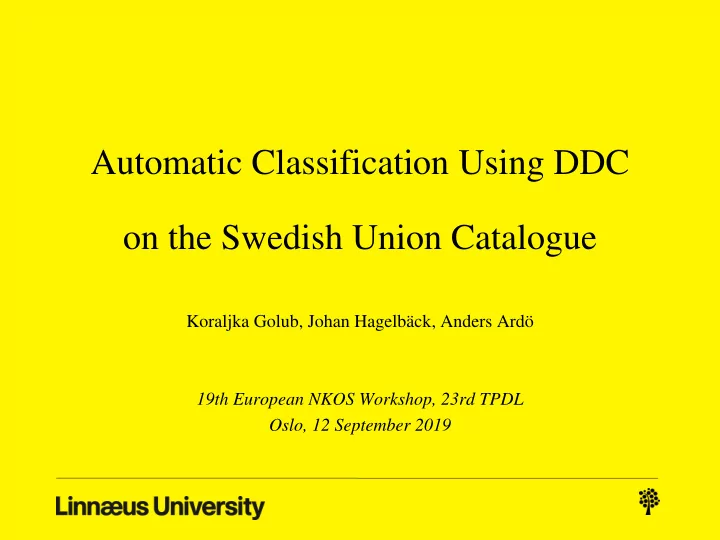

Automatic Classification Using DDC on the Swedish Union Catalogue Koraljka Golub, Johan Hagelbäck, Anders Ardö 19th European NKOS Workshop, 23rd TPDL Oslo, 12 September 2019
Contents 1. Purpose and aims 2. Method 3. Results 4. Future research
Purpose and aims • To establish the value of automatically produced classes for Swedish digital collections • Aims • Develop (and evaluate) automatic subject classification for Swedish textual resources from the Swedish union catalogue (LIBRIS) • http://libris.kb.se • Data set: 143,756 catalogue records containing DDC in LIBRIS • Using a machine learning approach • Multinomial Naïve Bayes (NB) • Support Vector Machine with linear kernel (SVM)
Rationale… • Lack of subject classes and index terms from KOS in new digital collections
… Rationale • DDC chosen as a new national ‘standard’ in 2013 SAB DDC • LIBRIS has a large collection of resources with DDC assigned to Swedish resources to train on • Explore automatic classification on Swedish DDC interoperability, cross- search, multilingual, international…
Contents 1. Purpose and aims 2. Method 3. Results 4. Future research
DDC • 23rd edition, MARCXML format • 128 MB relevant info extracted into MySQL database, total of 14,413 classes
Data collection • LIBRIS: 143,838 catalogue records in April 2018 • Using OAIPMH protocol, MARCXML format • All LIBRIS records with 082 MARC field for DDC class • Relevant info extracted into MySQL: • DDC classes truncated to 3-digit codes, to maximise training quality
Training problem: imbalance between classes • The most frequent class is 839 (Other Germanic literatures) with 18,909 records • In total 594 classes have less than 100 records (70 of those have only 1 single record) A dataset called “major classes” containing only classes with at least 1,000 records: • 72,937 records spread over 29 classes (60,641 records spread over 29 classes when selecting records with keywords)
The different datasets generated from the raw LIBRIS data
Classifiers • Pre-processing • Bag-of-words approach (stop-words retained) over 130,000 unique words • Unigrams and 2-grams • TF-IDF scores • Multinomial Naïve Bayes (NB) and Support Vector Machine with linear kernel (SVM) algorithms • Both have been used in text classification numerous times with good results • SVM typically better results than NB, but slower to train • NB can be trained incrementally, i.e. new training examples can be added without having to retrain the model with all training data
Evaluation measure • Accuracy • Amount of correctly classified examples Correctly classified examples Accuracy = % Total number of examples
Contents 1. Purpose and aims 2. Method 3. Results 4. Future research
Major results • SVM better than NB on all classes • On test set, best result 81.4% accuracy for classes with over 1,000 training examples, or 58.1% accuracy for all classes • When using both titles and keywords , unigrams and 2-grams • Features • Number of training examples significantly influences performance • Keywords better than titles, keywords + titles best • Stemming only marginally improves results
NB SVM
Top two levels, all examples from all classes • Accuracy increased from 58.1% (three digits, 802 classes) to 73.3% (two digits, 99 classes)
Stopwords and less frequent words • For major classes • Removed stopwords (_sw) reduced accuracy in most cases • Removed less frequent words from the bag-of-words (_rem) increased accuracy from 81.8% to 82.2%
Word embeddings • Word embeddings combined with different types of neural networks: • Simple linear network (Linear) • Standard neural network (NN) • 1D convolutional neural network (ConvNet) • Recurrent neural network (RNN) • Worse results than NB/SVM, but very close (80.8% compared to 82.2%) • Advantage of word embeddings is having a smaller representation size (then the stored data takes less space)
Common misclassifications • Whole dataset: • Class 3xx (Social sciences, sociology & anthropology) • Other classes often misclassified as belonging to 3xx • 3xx often misclassified as other classes • Most misclassifications between 3xx and 6xx (Technology) • Major classes dataset: • Fiction – mostly based on language and country • 823 (English fiction) misclassified as 839 (Other Germanic literatures) • 813 (American fiction in English) misclassified as 823 and 839 • 306 (Culture and institutions) misclassified as 305 (Groups of people)
Contents 1. Purpose and aims 2. Method 3. Results 4. Future research
Try improve algorithm performance… • More training examples • Through linked open data and URIs from elsewhere? • Include records with SAO and LCSH without DDC, and through the files with mappings of SAO and LCSH to DDC, try use them as training documents? • Norwegian / other catalogues in DDC?
…Try improve algorithm performance… • Take advantage of DDC • Establish how these contribute to classification accuracy
…Try improve algorithm performance • Evaluate ensemble learners combining different types of algorithms • String matching in the lack of training examples • Maui software http://www.medelyan.com/software • Scorpion approach https://www.oclc.org/research/activities/scorpion.html • Enrich with Swesaurus for more mappings and disambiguation https://spraakbanken.gu.se/resource/swesaurus
Evaluation • Test for all levels of classes • Test with algorithms outputting more than one class • Include misses in evaluation using measures like F-measure combining precision and recall • Manual evaluation to identify causes for successes and failures • Evaluate in the context of retrieval in real IR tasks
New forum for automatic indexing / classification • DCMI Automated Subject Indexing IG http://www.dublincore.org/groups/automated_subject_indexing_ig/ • Open to all • Place where we could collaborate? • Create open source solutions? • Annif (http://annif.org)
New IFLA WG • https://www.ifla.org/subject-analysis-and-access • Automated Subject Analysis and Access Working Group • https://www.ifla.org/node/92551
Thank you for your attention! • Questions? Feedback? • What does the practice want to see? • For which applications: Web Archives, repositories, CH collections, cross- search…? • Contact: koraljka.golub@lnu.se
Recommend
More recommend